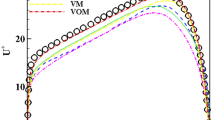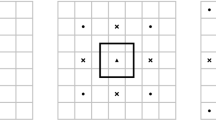Abstract
An anisotropy-resolving subgrid-scale (SGS) model for large eddy simulation was investigated. Primary attention was given to the predictive performance of the SGS model in the case of complex turbulence with flow impingement and/or flow separation. The SGS model was constructed by combining an isotropic linear eddy-viscosity model with an extra anisotropic term. Since the extra anisotropic term was modeled to prevent undesirable energy transfer between the grid-scale and SGS parts, the model is expected not to seriously affect computational stability. To validate the model performance for complex turbulent flow fields, the SGS model was applied to numerical simulations of a plane impinging jet and 3-D diffuser flow as well as fundamental plane channel flows. The SGS model provided reasonable predictions for these test cases. Furthermore, the predicted SGS stress components were decomposed into linear and anisotropic parts and their roles were investigated in detail. The usefulness of the present anisotropy-resolving SGS model in practical engineering applications was thus described.
Similar content being viewed by others
References
Smagorinsky, J.: General circulation experiments with the primitive equations: I. The basic experiment. Mon. Weather Rev. 91, 99–164 (1963)
Germano, M., Piomelli, U., Moin, P., Cabot, W.H.: A dynamic subgrid-scale eddy viscosity model. Phys. Fluids A 3, 1760–1765 (1991)
Lilly, D.K.: A proposed modification of the Germano subgridscale closure method. Phys. Fluids A 4, 633–635 (1992)
Bardina, J., Ferziger, J.H., Reynolds, W.C.: Improved subgrid scale models for large eddy simulation. AIAA Paper 80–1357 (1980)
Horiuti, K.: A proper velocity scale for modeling subgrid-scale eddy viscosities in large eddy simulation. Phys. Fluids A 5, 146–157 (1993)
Zang, Y., Street, R.L., Koseff, J.R.: A dynamic mixed subgrid-scale model and its application to turbulent recirculating flows. Phys. Fluids A 5, 3186–3196 (1993)
Vreman, B., Geurts, B., Kuerten, H.: On the formulation of the dynamic mixed subgrid-scale model. Phys. Fluids 6, 4057–4059 (1994)
Horiuti, K.: A new dynamic two-parameter mixed model for large-eddy simulation. Phys. Fluids 9, 3443–3464 (1997)
Sarghini, F., Piomelli, U., Balaras, E.: Scale-similar models for large-eddy simulations. Phys. Fluids 11, 1596–1607 (1999)
Morinishi, Y., Vasilyev, O.V.: A recommended modification to the dynamic two-parameter mixed subgrid scale model for large eddy simulation of wall bounded turbulent flow. Phys. Fluids 13, 3400–3410 (2001)
Abe, K.: An improved anisotropy-resolving subgrid-scale model with the aid of a scale-similarity modeling concept. Int. J. Heat Fluid Flow 39, 42–52 (2013)
Gatski, T.B., Speziale, C.G.: On explicit algebraic stress models for complex turbulent flows. J. Fluid Mech. 254, 59–78 (1993)
Craft, T.B., Launder, B.E., Suga, K.: Prediction of turbulent transitional phenomena with a nonlinear eddy viscosity model. Int. J. Heat Fluid Flow 18, 15–28 (1997)
Abe, K., Kondoh, T., Nagano, Y.: On Reynolds stress expressions and near-wall scaling parameters for predicting wall and homogeneous turbulent shear flows. Int. J. Heat Fluid Flow 18, 266–282 (1997)
Inagaki, M.: A new wall-damping function for large eddy simulation employing Kolmogorov velocity scale. Int. J. Heat Fluid Flow 32, 26–40 (2011)
Abe, K.: A hybrid LES/RANS approach using an anisotropy-resolving algebraic turbulence model. Int. J. Heat Fluid Flow 26, 204–222 (2005)
Moser, R.D., Kim, J., Mansour, N.N.: Direct numerical simulation of turbulent channel flow up to Re τ = 590. Phys. Fluids 11, 943–945 (1999)
Hattori, H., Nagano, Y.: Direct numerical simulation of turbulent heat transfer in plane impinging jet. Int. J. Heat Fluid Flow 25, 749–758 (2004)
ERCOFTAC workshop. In: Jakirlic, S., Kadavelil, G., Sirbubalo, E., Borello, D., (eds.) Proc. 14th SIG15 ERCOFTAC Workshop on Refined Turbulence Modelling, Case 13.2: Flow in a 3-D Diffuser, Rome (2009)
Cherry, E.M., Elkins, C.J., Eaton, J.K.: Geometric sensitivity of three-dimensional separated flows. Int. J. Heat Fluid Flow 29, 803–811 (2008)
Muto, M., Tsubokura, M., Oshima, N.: Negative Magnus lift on a rotating sphere at around the critical Reynolds number. Phys. Fluids 24, 014102 (2012)
Kim, J., Moin, P.: Application of a fractional-step method to incompressible Navier–Stokes equations. J. Comput. Phys. 59, 308–323 (1985)
Amsden, A.A., Harlow, F.H.: A simplified MAC technique for incompressible fluid flow calculations. J. Comput. Phys. 6, 322–325 (1970)
Rhie, C.M., Chow, W.L.: Numerical study of the turbulent flow past an airfoil with trailing edge separation. AIAA J. 21, 1525–1532 (1983)
Inagaki, M., Kondoh, T., Nagano, Y.: A mixed-time-scale SGS model with fixed model-parameters for practical LES. J. Fluids Eng. 127, 1–13 (2005)
Author information
Authors and Affiliations
Corresponding author
Rights and permissions
About this article
Cite this article
Abe, Ki. An Investigation of SGS Stress Anisotropy Modeling in Complex Turbulent Flow Fields. Flow Turbulence Combust 92, 503–525 (2014). https://doi.org/10.1007/s10494-013-9495-3
Received:
Accepted:
Published:
Issue Date:
DOI: https://doi.org/10.1007/s10494-013-9495-3




